2013 Peugeot 508 RXH fuel cap
[x] Cancel search: fuel capPage 10 of 308
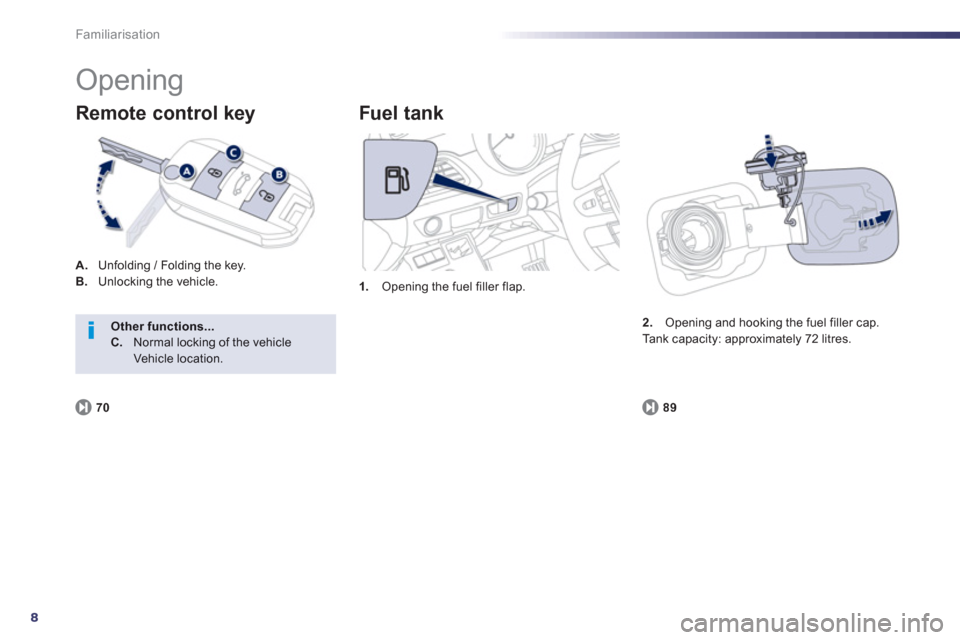
8
Familiarisation
Opening
A.
Unfolding / Folding the key.B.Unlocking the vehicle.
Remote control key
1.Opening the fuel filler flap.
Fuel t ank
89
2.Opening and hooking the fuel filler cap.
Tank capacity: approximately 72 litres. Other functions...C.Normal locking of the vehicle Vehicle location.
70
Page 32 of 308
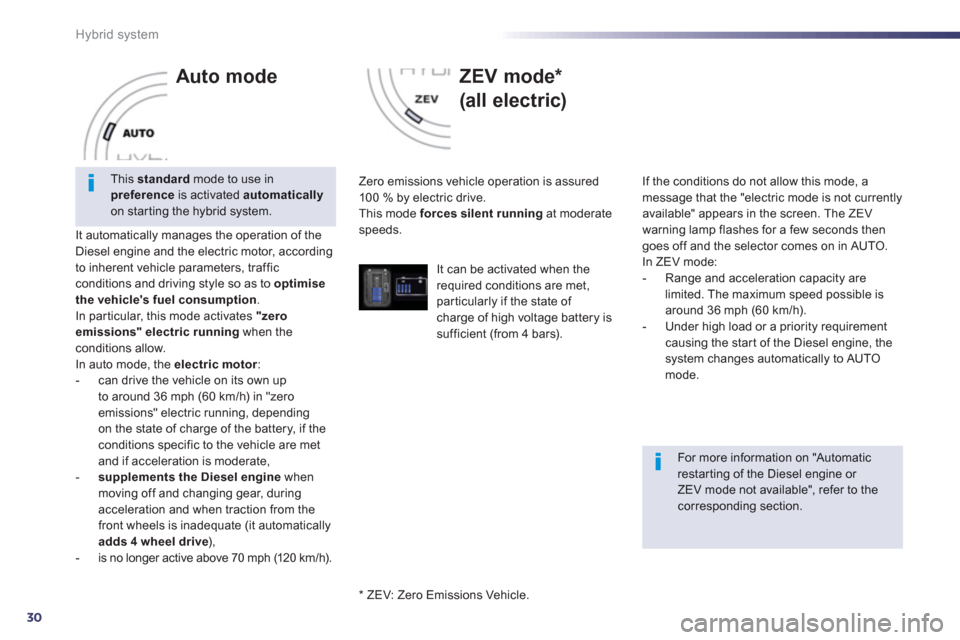
30
Hybrid system
Auto mode
It automatically manages the operation of the
Diesel engine and the electric motor, according
to inherent vehicle parameters, traffic
conditions and driving style so as to optimise
the vehicle's fuel consumption.In par ticular, this mode activates "zero emissions" electric runningwhen theconditions allow.
In auto mode, the electric motor
:
- can drive the vehicle on its own up
to around 36 mph
(60 km/h) in "zero
emissions" electric running, dependingon the state of charge of the battery, if the conditions specific to the vehicle are metand if acceleration is moderate, -supplements the Diesel enginewhen moving off and changing gear, during acceleration and when traction from thefront wheels is inadequate (it automaticallyadds4 wheel drive ),
- is no longer active above 70 mph (120 km / h).
ZEV mode *
(all electric)
Zero emissions vehicle operation is assured
10 0 % by electric drive.
This mode forces silent runningat moderatespeeds.
If the conditions do not allow this mode
, amessage that the "electric mode is not currentlyavailable" appears in the screen. The ZEV
warning lamp flashes for a few seconds then
goes off and the selector comes on in AUTO.
In ZEV mode:
- Range and acceleration capacity are
limited. The maximum speed possible is
around 36 mph (60 km/h).
- Under high load or a priority requirement causing the star t of the Diesel engine, thesystem changes automatically to AUTO mode.
This standard
mode to use inpreferenceis activated automaticallyon star ting the hybrid system.
For more information on "Automaticrestarting of the Diesel engine or ZEV mode not available", refer to the corresponding section.
*
ZEV: Z
ero Emissions Vehicle.
It can be activated when therequired conditions are met, particularly if the state of charge of high voltage battery is sufficient (from 4 bars).
Page 33 of 308
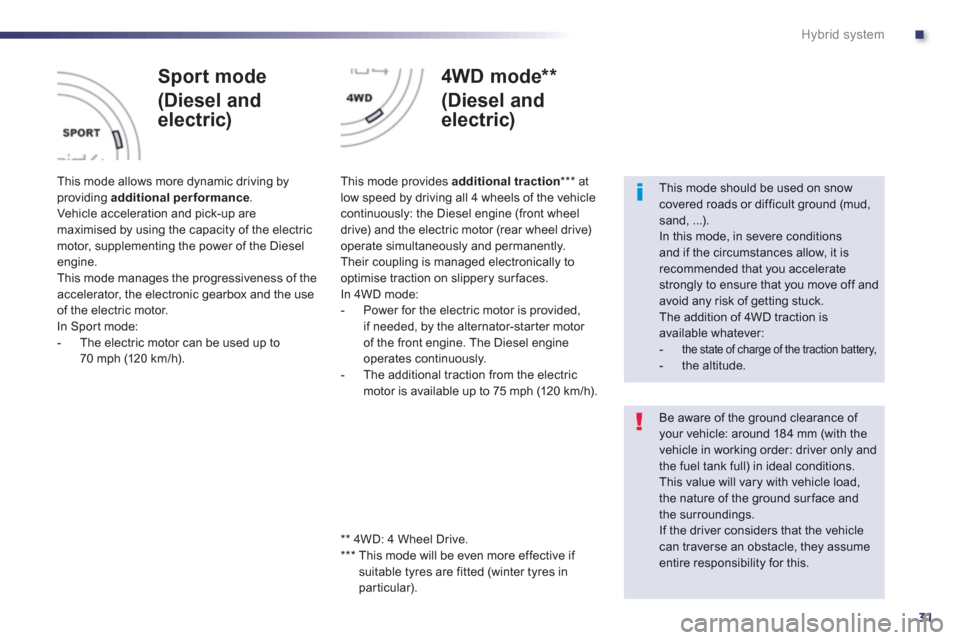
.
31
Hybrid system
Sport mode
(Diesel and
electric)
This mode allows more dynamic driving byproviding additional performance. Vehicle acceleration and pick-up aremaximised by using the capacity of the electricmotor, supplementing the power of the Dieselengine.
This mode manages the progressiveness of the
accelerator, the electronic gearbox and the useof the electric motor.
In Spor t mode:
-
The electric motor can be used up to
70 mph (120 km/h).
4WD mode **
(Diesel and
electric)
This mode provides additional traction*** at low speed by driving all 4 wheels of the vehiclecontinuously: the Diesel engine (front wheel
drive) and the electric motor (rear wheel drive)
operate simultaneously and permanently.
Their couplin
g is managed electronically to
optimise traction on slippery surfaces.
In 4WD mode:
- Power for the electric motor is provided,
if needed, b
y the alternator-star ter motor
of the front engine. The Diesel engine
operates continuously.
- The additional traction from the electric
motor is available up to 75 mph (120 km/h).
This mode should be used on snow covered roads or difficult ground (mud,sand, ...).
In this mode, in severe conditions and if the circumstances allow, it is recommended that you accelerate strongly to ensure that you move off and avoid any risk of getting stuck.
The addition of 4WD traction isavailable whatever:
- the state of charge of the traction battery,
- the altitude.
Be aware of the ground clearance of your vehicle: around 184 mm (with the vehicle in working order: driver only and the fuel tank full) in ideal conditions.
This value will vary with vehicle load,the nature of the ground surface and the surroundings.
If the driver considers that the vehicle
can traverse an obstacle, they assumeentire responsibility for this.
**
4WD: 4 Wheel Drive.
***
This mode will be even more effective if suitable tyres are fitted (winter tyres in
particular
).
Page 39 of 308
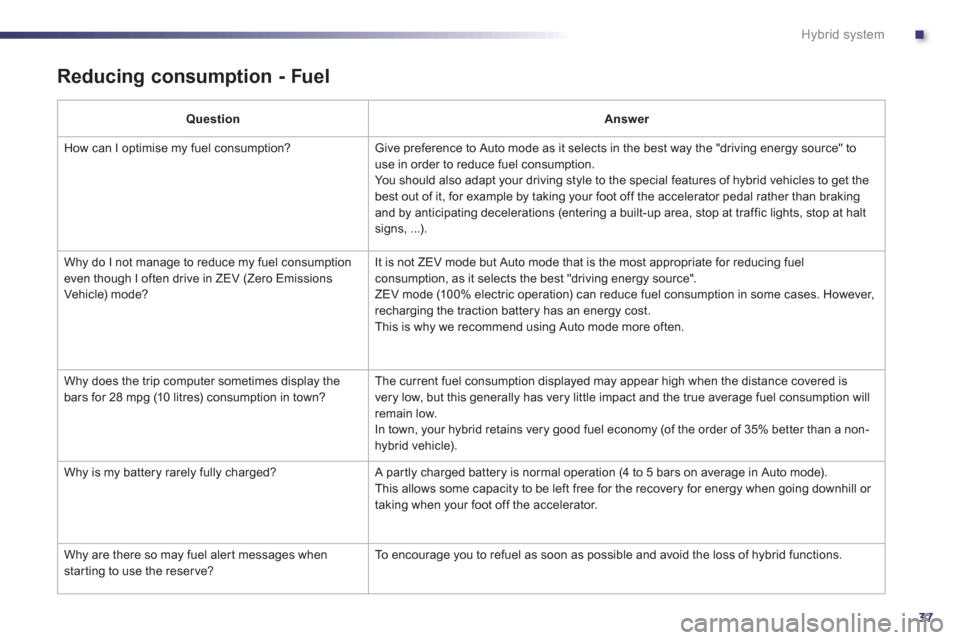
.
37
Hybrid system
Reducing consumption - Fuel
QuestionAnswer
How can I optimise m
y fuel consumption? Give preference to Auto mode as it selects in the best way the "driving energy source" to
use in order to reduce fuel consumption.
You should also adapt your driving style to the special features of hybrid vehicles to get the
best out of it, for example by taking your foot off the accelerator pedal rather than braking and by anticipating decelerations (entering a built-up area, stop at traffic lights, stop at halt
signs, ...).
Wh
y do I not manage to reduce my fuel consumptioneven though I often drive in ZEV (Zero EmissionsVehicle) mode? It is not ZEV mode but Auto mode that is the most appropriate for reducin
g fuelconsumption, as it selects the best "driving energy source".
ZEV mode (10 0% electric operation) can reduce fuel consumption in some cases. However,recharging the traction battery has an energy cost.
This is why we recommend using Auto mode more often.
Wh
y does the trip computer sometimes display the
bars for 28 mpg (10 litres) consumption in town?The current fuel consumption displayed may appear high when the distance covered is
very low, but this generally has very little impact and the true average fuel consumption willremain low.
In town, your hybrid retains very good fuel economy (of the order of 35% better than a non-hybrid vehicle).
Wh
y is my battery rarely fully charged? A par tly charged battery is normal operation (4 to 5 bars on average in Auto mode).
This allows some capacity to be left free for the recovery for energy when going downhill or
taking when your foot off the accelerator.
Wh
y are there so may fuel aler t messages whenstarting to use the reser ve?To e n c o u r age you to refuel as soon as possible and avoid the loss of hybrid functions.
Page 91 of 308
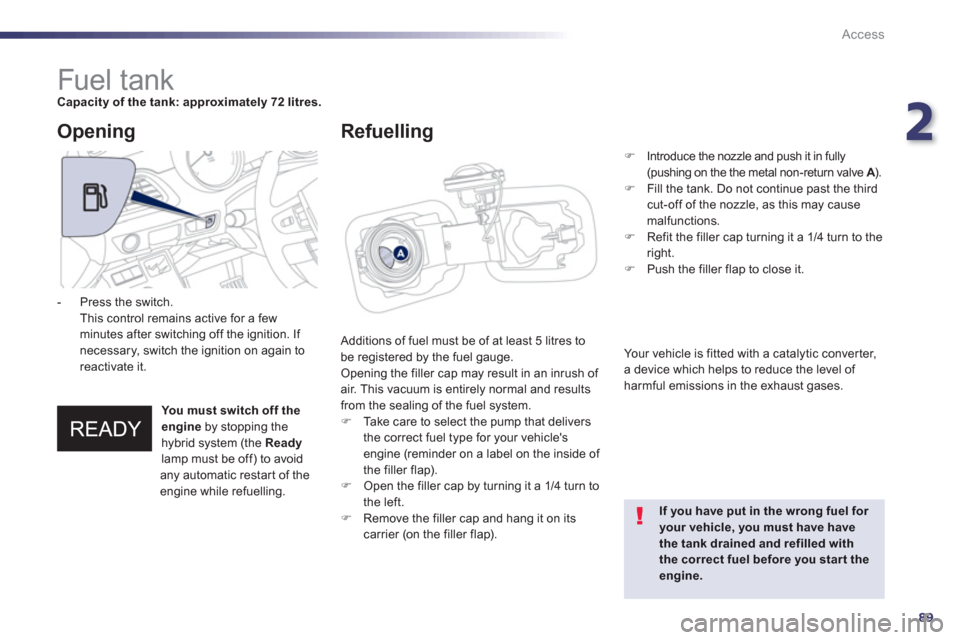
2
89
Access
Fuel tank Capacity of the tank: approximately 72 litres.
Additions of fuel must be of at least 5 litres to
be registered by the fuel gauge.Opening the filler cap may result in an inrush of air. This vacuum is entirely normal and results from the sealing of the fuel system.�) Take care to select the pump that delivers
the correct fuel t
ype for your vehicle'sengine (reminder on a label on the inside of
the filler flap).�) Open the filler cap by turning it a 1/4 turn to
the left. �) Remove the filler cap and hang it on its carrier (on the filler flap).
Opening
If you have put in the wrong fuel for your vehicle, you must have havethe tank drained and refilled with the correct fuel before you start theengine.
- Press the switch.
This control remains active for a fewminutes after switching off the ignition. If necessary, switch the ignition on again toreactivate it.
Refuelling
�)
Introduce the nozzle and push it in fully(pushing on the the metal non-return valve A
). AA�)
Fill the tank. Do not continue past the thirdcut-off of the nozzle, as this may cause malfunctions. �)
Refit the filler cap turning it a 1/4 turn to the
right. �) Push the filler flap to close it.
Your vehicle is
fitted with a catalytic converter,
a device which helps to reduce the level of
harmful emissions in the exhaust gases.
You must switch off theengine by stopping the
hybrid system (the Readylamp must be off) to avoid any automatic restar t of the
engine while refuelling.
Page 92 of 308
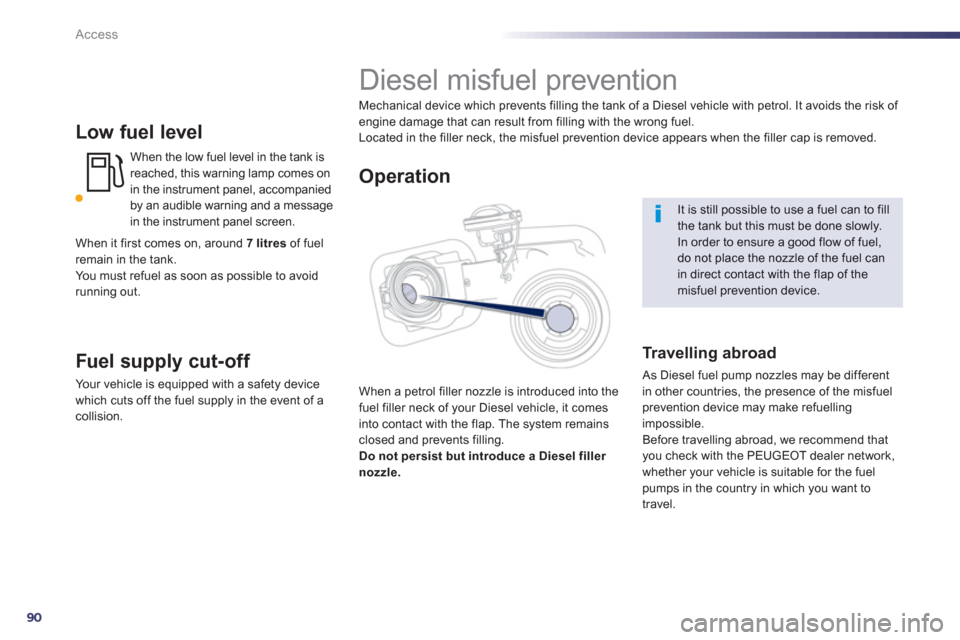
90
Access
Low fuel level
When the low fuel level in the tank isreached, this warning lamp comes on in the instrument panel, accompanied by an audible warning and a message
in the instrument panel screen.
Fuel supply cut-off
Your vehicle is equipped with a safety device
which cuts off the fuel supply in the event of a collision.
It is still possible to use a fuel can to fill
the tank but this must be done slowly. In order to ensure a good flow of fuel, do not place the nozzle of the fuel canin direct contact with the flap of themisfuel prevention device.
Diesel misfuel prevention
Mechanical device which prevents filling the tank of a Diesel vehicle with petrol. It avoids the risk of engine damage that can result from filling with the wrong fuel.
Located in the filler neck, the misfuel prevention device appears when the filler cap is removed.
When a petrol
filler nozzle is introduced into the fuel filler neck of your Diesel vehicle, it comes
into contact with the flap. The system remains
closed and prevents filling. Do not persist but introduce a Diesel filler
nozzle.
Operation
Tr a v e l l i ng abroad
As Diesel fuel pump nozzles may be different
in other countries, the presence of the misfuel prevention device may make refuellingimpossible.
Before travelling abroad, we recommend that you check with the PEUGEOT dealer network,
whether your vehicle is suitable for the fuelpumps in the country in which you want to
travel.
When it
first comes on, around 7 litresof fuelremain in the tank.
You must refuel as soon as possible to avoid
running out.
Page 113 of 308

3
111
Comfort
In order for these systems to be fully effective, follow the operation and maintenance guidelines below: �)
If the interior temperature remains very high after the vehicle has been parked in the sunfor a considerable time, first ventilate the passenger compar tment for a few minutes. Place the air flow control at a sufficient level to provide an adequate renewal of air in the passenger compartment.�)
To obtain an even air distribution, take care not to obstruct the exterior air intake grilles located at the base of the windscreen, the nozzles, the vents and the air outlets, as wellas the air extractor located in the boot. �)
Use in preference the intake of exterior air as prolonged use of the air recirculation maycause misting of the windows and side windows.�)
Do not cover the sunshine sensor, located on the dashboard; this is used for regulation of the automatic air conditioning system.�)
Operate the air conditioning system for 5 to 10 minutes, once or twice a month to keep itin good working order. �)
Ensure that the passenger compar tment filter is in good condition and have the filter elements replaced regularly (refer to the "Checks" section). We recommend the use of a combined passenger compar tment filter. Thanks to its second special active filter, it contributes to the purification of the air breathed by the occupants and the cleanliness of the passenger compartment (reduction of allergic symptoms, bad odours and greasy deposits).�)
The air conditioning uses power from the engine while operating. This results in anincrease in the vehicle's fuel consumption. When towing at or near maximum capacity or on steep slopes in high ambient temperatures, switching off the air conditioning saves engine power and so improvestowing capacity. Condensation created by the air conditioning results in a discharge of water under thevehicle when stationary, which is per fectly normal.�)
To ensure correct operation of the air conditioning system, you are also advised to haveit checked regularly.�)
If the system does not produce cold air, do not use it and contact a PEUGEOT dealer or a qualified workshop.
Recommendations for ventilation and air conditioning
The air conditioning system does notcontain chlorine and does not present any danger to the ozone layer.
Page 225 of 308

9
223
Checks
The various caps and covers allow access for checking the levels of the various fluids, for
replacing cer tain components and for primingthe fuel system.
Diesel engine
1.
Power steering reservoir.2.Screenwash and headlamp wash reservoir.3.Coolant reservoir.4.
Brake fluid reservoir.
5. Battery / Fuses.
6.Fusebox.7. Air filter.8.Engine oil dipstick.9.
Engine oil filler cap.10.Priming pump.11.
Bleed screw.
Before doing anything under the bonnet,switch off the ignition (Ready
lamp off) to avoid any risk of injury resulting fromautomatic operation of the engine.